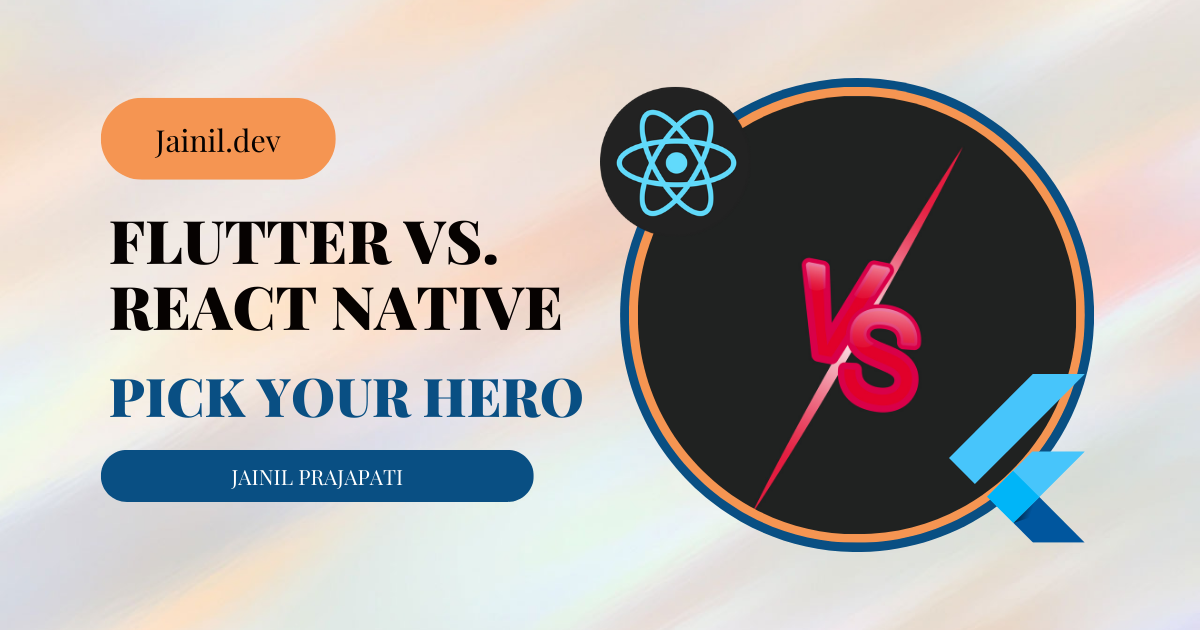Flutter vs. React Native: Pick Your Hero
 Jainil Prajapati
Jainil Prajapati
One of the most popular searches on the internet right now is “React Native vs. Flutter.” The two of them are the best cross-platform on the market right now, which is why this comparison is being made.
The cornerstone of the technological world has always been building cross-platform mobile apps.
Most businesses prefer to select a cross-platform framework when creating a new application or updating an existing one.
Benefits of Cross-Platform Development
Here are a few justifications for developing apps in a cross-platform manner:
- Cost-Saving Approach
- faster time to market, reusable code
- Uniformity across UI Components
- Simple Cloud Integration and Plugin Access
The need for cross-platform frameworks is growing as a result of their numerous advantages. And this is yet another cause of the confusion that results in the comparison of React Native and Flutter. The two strongest contenders for the cross-platform framework are React and Flutter.
Let’s first briefly describe these technologies before starting to compare them based on various criteria.
React Native:
React Native is based on React, Facebook’s JavaScript library, to keep things brief and simple (used for building the user interfaces). This framework lets React Native developers create JSX, a hybrid of JavaScript and XML-Esque markup similar to React for web applications.
This framework, however, is focused on mobile platforms, unlike React.
Flutter:
A mobile app SDK called Flutter enables you to write your application in a single codebase and cross-compile it for iOS and Android. Flutter also lowers costs by combining various processes into a single cycle.
Applications for Flutter are created using the object-oriented programming language Dart. Additionally, the Flutter UI is a synthesis of various widgets.
Choose Your Hero: React Native vs. Flutter
What is the difference between React Native and Flutter?
Both React Native and Flutter platforms enable businesses to have a single mobile app codebase for both operating systems (iOS and Android). So, what’s the difference? Let us investigate:
1. Performance:
On based performance, Flutter clean the competition. Flutter makes use of excellent performance profiling tools, such as the Dart Programming Language’s DevTools.
The Flutter Inspector is included in the DevTools, which allows Flutter developers to visualise and explore Flutter widget trees. Furthermore, compiling code with the C and C++ libraries significantly improves the performance of the Flutter app.
React Native developers, on the other hand, face issues with architecture, libraries, and native components, particularly when developing hybrid apps. If you are comparing react vs flutter performance, you should definitely hire flutter developers and get your project started.
Winner: Flutter
2. User Interface:
The user interface of a platform, like its performance, can make or break it. As a result, when comparing the two programming languages, the user interface becomes an important factor.
In the battle of React vs. Flutter, React Native clearly wins. It’s simply because it has more native iOS and Android components. Because React Native lacks its own library of UI components.
As a result, creating an interactive user interface may necessitate the use of third-party libraries. Here is a list of the most popular React Native libraries:
- Components for NativeBase
- Shoutem User Interface Components
- Native Elements in React
Flutter hybrid apps, on the other hand, make use of proprietary widgets. To make the UI of the application more interactive, Flutter developers can use Material components, Interaction Models, Styling, Text, Scrolling, Cupertino (iOS-style widgets), and so on.
These widgets are built-in UI components that replace native components. Furthermore, Flutter’s layered architecture allows developers to experiment with the application and control every single pixel on the app screen. Without being biased, you should definitely go ahead with react native app development in this performance parameter.
Winner: React Native
3. Development Time:
The development time of an application is critical to its success. As a result, mobile app developers must work under extremely tight deadlines.
Strict deadlines only add to your developers’ stress and may result in negative outcomes. As a result, it is critical to select a mobile app development technology that allows for rapid app development.
One of the most significant advantages of React Native is the availability of ready-to-use components. Aside from that, it makes use of the Redux framework to manage and track changes in the application’s state.
Furthermore, the hot-reloading feature enables developers to quickly review changes to the mobile UI. This significantly reduces the time required to develop the app.
Recommended Reading: Why is React Native superior to other similar platforms?
Flutter requires you to include separate files for both iOS and Android. Furthermore, both of these files necessitate the addition of platform-specific code.
Aside from this issue, Flutter has a hot-reloading feature that allows developers to instantly check the output. This feature saves developers from having to start from scratch when making changes. As a result, Flutter allows for rapid development. However, when comparing React Native vs Flutter, React emerges as the clear winner.
Winner: React Native
4. Documentation and Toolkit:
Documentation always takes time. Flutter, on the other hand, provides regimented and smooth documentation that mobile app developers can refer to while developing the app. Flutter comes with a plethora of Integrated Development Environments (IDEs) and tools. Furthermore, Flutter works well with Visual Studio, which adds value to the framework. So, if you want clear documentation, consider Flutter development.
On the contrary, React Native documentation is disorganised and clumsy. Because React Native’s documentation process left many things out, developers must rely on external dev kits for assistance.
Winner: Flutter
5. Stability
Another important factor to consider when comparing React Native and Flutter is stability. React Native is a well-known framework that has long been praised for its features and dependability. It also has a large contributor community.
In the beginning, the alpha version of Flutter was not recommended for large projects. The Flutter beta 2 version included a few noteworthy features for developers. However, with the release of a stable version of Flutter in July 2019, things have changed dramatically. Here’s what the new Flutter Stable Release has to offer:
- iOS and Material Widgets updates
- Tools and plugin updates
- The In-App Purchase Feature is introduced.
- Support for the newly revised Apple Store policy.
Recommended Check out the Top 8 Reasons to Invest in Flutter Development.
Before the release of Flutter’s stable version, React Native was the clear winner due to its maturity and large community. However, with the release of a new version of Flutter, it has become worthwhile to invest.
React Native vs Flutter Comparison Table:
We compared Flutter and React Native in terms of performance, documentation, stability, development time, and user interface. However, picking a clear winner is extremely difficult. Both of these frameworks have advantages and disadvantages.
We can place our bets with confidence on React Native. We are positively utilising this technology now that Flutter has also become stable and mature. In fact, the majority of our clients
Subscribe to my newsletter
Read articles from Jainil Prajapati directly inside your inbox. Subscribe to the newsletter, and don't miss out.
Written by

Jainil Prajapati
Jainil Prajapati
I am learning web development. I am exploring various technologies in Web Development and learning new technologies on a required basis. Else, I understand required technologies and implement them directly on the project. I am currently working as a Web Developer on my projects and sometimes freelance projects just to explore and learn new things about client requirements.